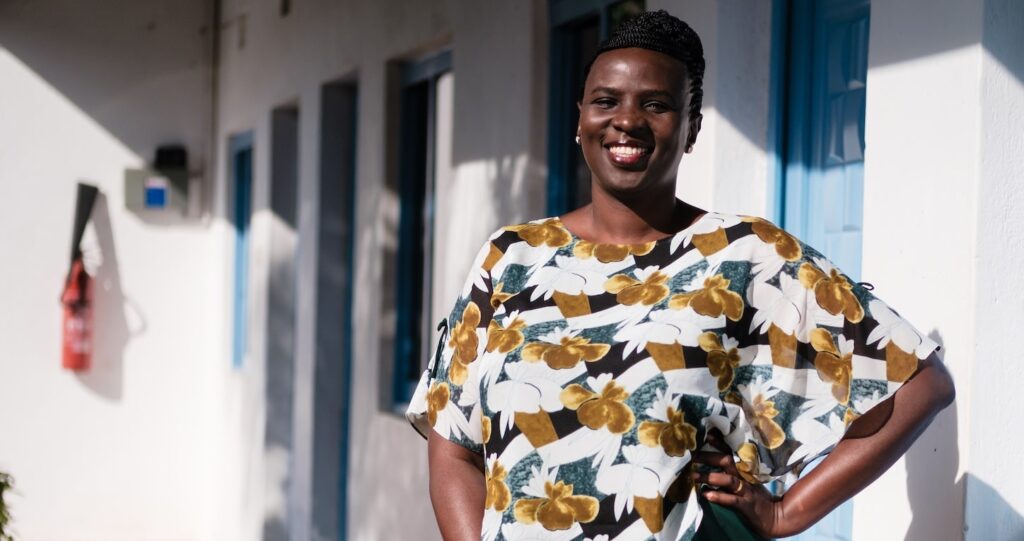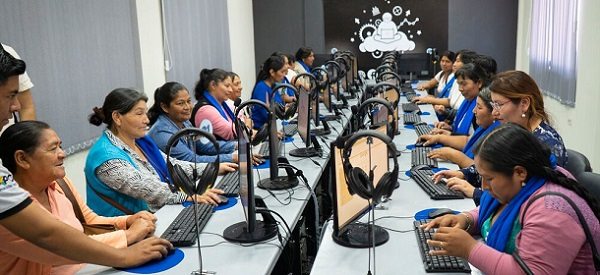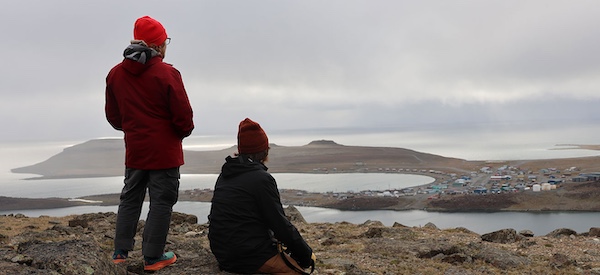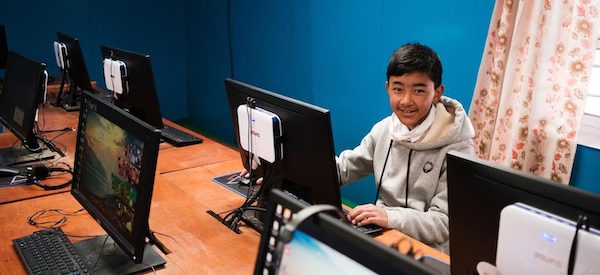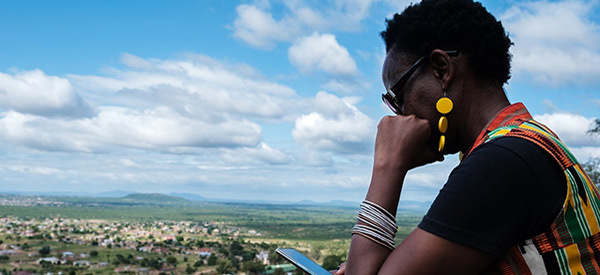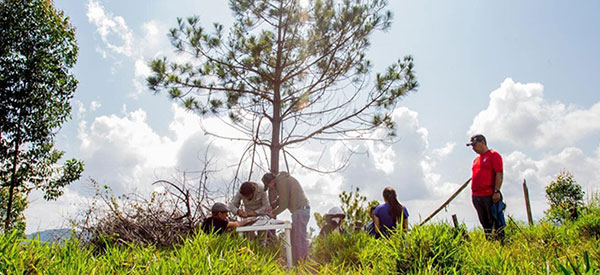List of posts displayed on a map
Africa
Mankosi Community Network In response to the State of Disaster pronounced in March in South Africa, and the subsequent lockdown in 2020, Zenzeleni community networks worked within the rural communities of Mankosi and Zithulele to enable access to affordable Internet resources and information. The project included a free Digital Community Notice Board and zero-rated education and health websites. The network also provides computer labs in Mankosi’s primary and secondary schools and computer literacy training for teachers.
Pamoja Net Pamoja Net is a community network created by the organization La Différence in 2016. Thanks to Pamoja Net, the population of the island of Idjwi in Lake Kivu (Democratic Republic of Congo) can easily access the Internet.
The sustainability of Pamoja Net is based on businesses that pay for dedicated access during the working day. These clients make it possible for the community network to provide free Wi-Fi to the community from 16:00 onward. However, there are times when the clients do not pay because of technical issues when the connection is down. The project aims to put in place a solution that addresses the technical issues and enables Pamoja Net to cover all its costs.
Murambinda Works Murambinda Works is a community network in Zimbabwe’s rural Buhera district. It is comprised of four community Wi-Fi spots that provide connectivity to surrounding schools, the nurses training school, council offices, households, and farms. It also connects the cyber café, financial service providers, the hospital, and local government offices.
Mamaila Community Network Kgopotso Magoro, inspired by an OpEd that claimed that “coming from a rural area is like being cursed” for the lack of opportunities available, started a journey that would lead to the creation of the Mamaila Community Network.
Fantsuam Foundation Fantsuam Foundation was founded in 1996 to empower community members, particularly women, to find means of employment and income and meet their own development needs.
Working in 53 communities across 7 local government areas in Kaduna State, close to 15,000 individuals benefit from Fantsuam’s services every year. It was estimated that by 2018, over 400,000 people have benefited either directly or indirectly from Fantsuam Foundation’s activities.
BOSCO Uganda Battery Operated System for Community Outreach (BOSCO) Uganda is a not-for-profit, faith-based organization founded in 2007 in the Gulu district in Northern Uganda. With about six ICT centers at the beginning, BOSCO Uganda now has about 55 rural community network-based development centers with over 60,000 beneficiaries in the Northern and West Nile regions in Uganda, part of them supported by the Internet Society in 2020.
Groot-Aub Community Network As part of the Afchix initiative promoting women in establishing, using, and managing community networks, the Groot-Aub Community Network has been run and supported by the Internet Society Namibia Chapter since 2021.
Lanet Umoja Community Network In Lanet Umoja, Nakuru, a rural community about 250 kilometers from Kenya’s capital city Nairobi, Internet access is expensive. The community network’s primary purpose is to increase the capacity of women in the ICT sector, provide internet access & digital tools to the community at large.
Ait Izdeg Community Network AFCHIX leads this community network to expand Internet access in rural areas in Ait Izdeg, Morocco. The project focuses on training local women to maintain the infrastructure and develop sustainable business plans to establish and manage community networks. These digital training programs also teach technical skills to install and maintain the hardware necessary to run a community network, including towers and modems, which opens up entrepreneurship.
Ekwendeni Community Network The Ekwendeni Community Network project is an initiative implemented by the Centre for Youth and Development with funding from the Internet Society since 2022. The project aims to set up an infrastructure that will be the gateway for the community to access information and improve education, health, and economicopportunities for the general population. It is being implemented in conjunction with the Ekwendeni community under theleadership of the Inkosana Kajiso Shaba.
aherinet aherinet is a community wireless Internet service within Kisumu County. It was registered in 2020 as a pioneer community network in Kenya. It is currently offering affordable Internet connectivity to homes within Kisumu county outskirts and rural areas where most of the unserved population are increasing the connectivity levels in Kisumu County.
Abichikili Community Network Phase 1 of the Abichikili Community Network will serve the rural kebele of Abichikili and the small nearby town of Dur Betie in South Achefer Woreda of West Gojjam, Amhara National Regional State (ANRS). The services of the community network will be expanded to nearby rural communities, including Ahuri and Tadra, and provide connectivity to the customers within a 30-km radius of the base station. As Dur Betie is along the Addis Abeba-Bahir Dar highway, major operators could come there anytime. Cognizant of this, the focus in phase II will be on serving rural communities that are off the highway and which will likely not be the near-term targets of telecom providers.
Latin America & Caribbean
Oaxaca Community Network Working with the Internet Society and the the Internet Society Mexico Chapter, REDES AC and several organizations partnered in 2018 to deploy community networks in four Indigenous communities: Ayuujk, Zapotec, Wixárika, and Tseltal. Since then, they have worked closely with the Internet Society and received further support.
El Cuy Community Network In 2019 there was no Internet or mobile connection in the isolated town of El Cuy, population 540. In a remote area of the Argentinean Patagonia, community members worked with the Internet Society to deploy their first community network, which was ready just as COVID hit in 2020 and helped them stay safe and to access public services during the pandemic.
RedINC Community Network In partnership with the Internet Society in 2020 and 2021, a pacified zone in Colombia, formerly occupied by guerrilla warriors, started overcoming decades of conflict and isolation, building its own community network and connecting to the Internet. With the right policies, they might be able to keep it.
Espírito Santinho Until 2019, the Internet was out of reach for most residents in the rural community of Espírito Santinho, located in the state of Rio de Janeiro. Since then, they have deployed Brazil’s first fiber community network in a partnership model with a local small service provider.
Reyeshogpan Community Network A pilot effort in 2020 by the community of Reyeshogpan, Cuetzalan del Progreso, Puebla led to the development of an LTE Mobile Community Network Service by Telecomunicaciones Indígenas Comunitarias. The Mobile LTE final services were later implemented in Mexico and Colombia.
Santa Rosa Community Network Part of the NANUM initiative to connect Indigenous women in the Chaco. Over 2,000 people live in Santa Rosa. Connectivity was limited to expensive data packages through little mobile services that were not affordable to the local population. Local women worked in crafting. With their new community network, they hope connectivity will bring them the opportunity to trade their products with other communities and also help develop digital and financial skills.
Veryvine Community Network Farmers in Veryvine got together in December 2022 to kick off their first community network deployment. With Internet available, farmers plan to install smart devices and weather monitoring for more efficient and effective farming.
Puerto García Community Network Part of the NANUM initiative to connect communities in the Chaco region, the rural community of Puesto García built an Internet center in 2022 to empower Indigenous women. Since getting connectivity, they have expanded their agriculture businesses and developed skills in growing organic crops, providing them with a more sustainable livelihood.
Europe
Tusheti Community Network Working with the Internet Society in 2020, people in Tusheti—one of the highest settlements in Europe and an ecologically unspoiled community of historical and cultural significance in the Greater Caucasus Mountains of Georgia—built a community network to bring connectivity to one of the most isolated places on Earth.
Sarantaporo.gr Community Network Working in partnership with the Internet Society in 2018, 2020, and 2021, Sarantaporo.gr has connected several communities in Greece where people have been left behind by years of negligence with local operators. Their work is helping local farmers improve their livelihoods and access new sources of knowledge.
Shaghap Community Network In the mountainous village of Shaghap, in the Armenian region of Ararat, over 170 families live in a quiet area far from urban centers. Since they deployed their first community network in partnership with the local Union of Operators in 2021, they already have an expansion in mind and hosted the Europe Community Networks Summit in 2023.
Zardaly Community Network Zardaly, an isolated village up in the mountains in Southern Kyrgyzstan, is home to about 150 people who live without electricity and communication. A mountain trail is the only direct route to Zardaly, where donkeys are the most reliable transport. In 2021, the Internet Society Kyrgyzstan Chapter took the first steps to deploying a community network and installing infrastructure in a local school.
North America
NYC Mesh In New York City, 1.5 million people don’t have access from their homes or mobile devices, largely due to high costs of connectivity. NYC Mesh is continuing to expand its presence in underserved communities in NY, offering affordable Internet service. In 2020 they received support from the Internet Society to expand and bring more people online.
Waimanalo Community Network An independent nation in Hawai‘i builds the Internet from the ground up after partnering with the Internet Society in 2019, connecting to its sovereignty and the world. Since the deployment, people in Pu’uhonua o Waimanalo had the services they needed just before the COVID-19 outbreak while also increasing economic exchange. In 2022 they expanded the network to improve their services and bring more people online.
Baltimore Community Network With support from the Internet Society in 2020, a community built an Internet oasis in the city’s traditionally marginalized neighborhoods, known as connectivity deserts. What started as an effort to connect community centers during the pandemic now serves thousands.
Tuskegee’s Jesup Cyber Wagon Part of a successful partnership between the Internet Society and Truist, Alabama entrepreneur Boyd Stephens partnered with the Tuskegee Housing Authority and revisited a century-old idea to empower people through connectivity, bringing social and economic development to the local community.
Sunnyside Technology Hub Part of a successful partnership between the Internet Society and Truist in 2022, Sunnyside creates a broadband coverage area in the Sunnyside community of Houston in an area of flat terrain that lacks tall buildings.
MoCoNet Part of a successful partnership between the Internet Society and Truist in 2022, the project provides 100 Mbps MoCoNet broadband, Emergency Connectivity Fund devices and digital empowerment skills training, to enable residents to be independent and engage with each other as a community.
City of Wiliston Part of a successful partnership between the Internet Society and Truist in 2021, the City of Wiliston improves its broadband program, COWLink, to support efforts to improve broadband access and speed for local businesses, schools and homes.
City of Wilson Part of a successful partnership between the Internet Society and Truist in 2021, this project expands North Carolina’s Community Broadband fiber-to-the-home into a rural, majority-black community in Wilson County.
Wave 7 Part of a successful partnership between the Internet Society and Truist in 2021, Wave 7 connects residents of Enfield, North Carolina and outlying rural areas, trains digital stewards and provides online learning to residents.
Toronto Mesh With the support and collaboration of the Internet Society in 2020, Free Geek Toronto and many others-Toronto Mesh is launched the Toronto Community Network (TCN). Enhanced access and choice of digital tools represents a major benefit of participation in the Toronto Community Network. Participation directly contributes to community knowledge and resilience.
Seattle Community Network The Seattle Community Network (SCN) is a community-run cellular (4G LTE) Internet access network dedicated to providing fair access to underserved communities all across the Puget Sound.
The project is firmly grounded in the principles of community empowerment. The network is a participatory construction where local residents and institutions help each other in a collaborative and community-minded way.
Over the past two years, working with many community partners, SCN has been growing into a community-based grassroots organization running Internet infrastructure in King and Pierce Counties. While not as highly resourced or performant as paid enterprise networks, SCN is an open, volunteer-led organization dedicated to teaching and hands-on learning of the processes and tools of running production telecom networks at scale. SCN seeks to open source this knowledge and capability to enable other groups to do the same.
Connected Communities Part of a successful partnership between the Internet Society and Truist in 2022, Connected Communities deploys high-speed Wi-Fi at a DC Housing Authority property, connecting residents to devices, and facilitating digital literacy and skills training programs.
Fifth Ward Part of a successful partnership between the Internet Society and Truist in 2022, Fifth Ward provides up to 700 low-income families with Internet access and offers options for increasing digital literacy skills, installing public Wi-Fi benches, and adding antennas and nodes to community spaces.
Connecting for Good Part of a successful partnership between the Internet Society and Truist in 2022, Connecting for Good expands a project to connect low-income multi-dwelling unit buildings and nearby single-family homes across the city to free and low-cost broadband Internet service.
Roanoke Connect Broadband Part of a successful partnership between the Internet Society and Truist in 2022, Roanoke Connect Broadband expands a network to increase broadband access in rural northeast North Carolina counties with high poverty rates.
DCPS Overcome 21 Part of a successful partnership between the Internet Society and Truist in 2021, the Duval County Public Schools lead the Project OVERCOME21, a plan to turn schools in the Florida district into local broadband hubs for the surrounding community. The hubs boost signals to a three-mile radius and connect to the school district’s existing network.
Waianae Community Network Pu’uhonua o Waianae is a community on the west coast of Oahu in Hawai’i. Residents of Pu’uhonua Waianae participated in a network build in Pu’uhonua o Waimānalo in 2019 and are now ready to create a similar network in their own community. In conjunction with building houses and community buildings at the new location, residents are building the community network. Fiber termination is extended to the community gate by HawaiiTel.
Ulukhaktok Community Network Canada’s Northwest Territories has 33 communities, many of which are home to First Nations, Inuit, and Métis individuals. The territory’s vast geography and remote nature of many of the communities has made it difficult to introduce fast, affordable, and reliable Internet due to expensive costs of infrastructure and a lack of economic incentive to build robust infrastructure in the far North.
Asia-Pacific
Uttargaya Community Network Uttargaya Community Network was established in November 2021 in partnership with Nepal Internet Foundation. It serves nearly 600 internally displaced people from the 2015 Nepal earthquake. The network is located at Ward No 5 of the Uttargaya Rural Municipality Laharepauwa, Rasuwa, Nepal.
The network provides an aggregate of 10mbps wireless connectivity installed in a community common room. The network’s primary beneficiaries are children who use this connectivity for school activities and women for online businesses and communication.
Digital Dera Digital Dera Community Network was established in October 2021 in partnership with Accountability Lab and Agriculture Republic. It serves over 1,000 farmers from villages around Chak 26-SP in the Pakpattan district of Punjab province in Pakistan. The network provides an aggregate of 7mbps wireless connectivity installed in a village community center (Dera) building equipped with solar power, laptops, and multimedia equipment.
Through digital inclusion in rural areas, Digital Dera is enabling farmers to decide effectively, efficiently, and smartly using data, information, guidance, and technology. With strong potential to be replicated across the country, the result could be Pakistan’s sustainable, productive, and food-secure future.
Chirala Community Network Chirala Community Network was established in November 2022 in partnership with Digital Empowerment Foundation. It serves nearly 1,000 people in Vodarevu village in Chirala Mandal in the Prakasam District of Andhra Pradesh State, India. Vodarevu is a large fishing considered an Internet dark zone that lacks access to Education, information, entitlements, and rights.The network provides an aggregate of 400mbps wireless connectivity installed in several community digital resources centers. The network connects local villagers with the benefits of government welfare schemes/entitlements, digital literacy, citizen services, jobs, and setting up micro enterprises. One of the key highlights of this network is Chirala Fisherwomen Wifi Community Center, which empowers fisherwomen from this area.
Everest Community Network The Everest Community Network was established in July 2022 in partnership with Nepal Internet Foundation. It is located at an altitude of 3900m, making it one of the highest community networks in the world. It serves nearly 1,800 Sherpa people living in the Himalayas. The network is in Khunde and Khumjung villages of the Khumbu Pasangalhamu Rural Municipality, Nepal.
The network provided an aggregate of 10mbps wireless connectivity installed in Khumjung High School and Khunde Community Club. In May 2023, its infrastructure was upgraded to a fiber optical cable network with an aggregate bandwidth of 300mbps. The network’s primary beneficiaries are school children who use this connectivity for school activities and local Sherpa people for their livelihood, including trekking and mountain guide services.
Gabagaba Community Network Gabagaba Community Network was established in September 2022 in partnership with National ICT Authority (NICTA), Papua New Guinea. It serves over 100 fishermen from the Gabagaba coastal village in central Papua New Guinea (PNG).
The network provides an aggregate of 5mbps wireless connectivity installed in a container building equipped with two computers. The web supports local fishermen in using the Internet to access markets and information.
Lasbela Community Network WANG Lab of Innovation (WALI) Community Network was established in October 2022 in partnership with Welfare Association for New Generation (WANG). It serves nearly 400 children and youth from Ahmed Abad village of Lasbela district of Balochistan province in Pakistan. Balochistan is considered the least developed province of Pakistan.
The network provides an aggregate of 10mbps wireless connectivity installed in a community center building equipped with solar power, computers, and multimedia equipment. The network runs regular training classes on empowerment, social development, and technology adoption for local youth and children. This community network played an essential role during recent floodings in Lasbela, offering information sharing for relief and aid services through the Internet.
Ziro Community Network Ziro Community Network was established in December 2022 in partnership with Digital Empowerment Foundation. It serves nearly 1000 households in 100 villages in Ziro town. Ziro is a town in and the district headquarters of the Lower Subansiri district in the Indian state of Arunachal Pradesh.
The network provides an aggregate of 100mbps wireless connectivity installed in 10 community center buildings equipped with computers and multimedia equipment. The network runs regular training classes on content development, empowerment, and social development for local villagers.
